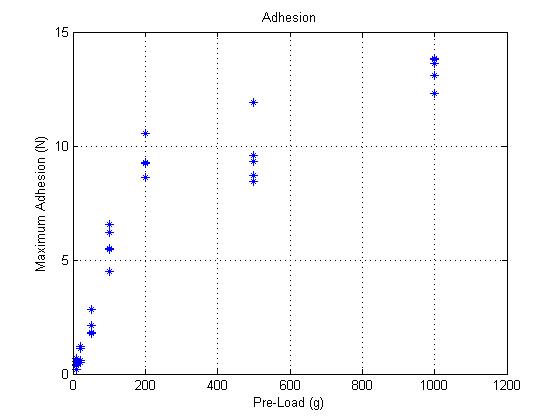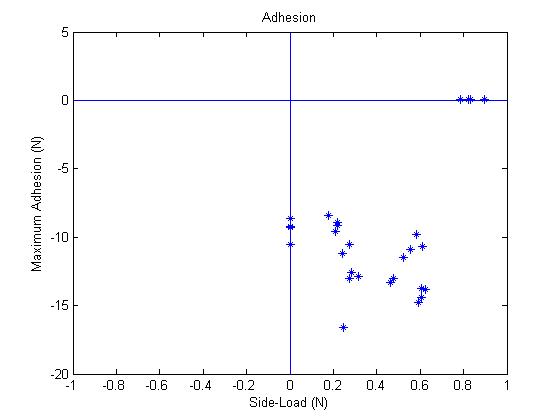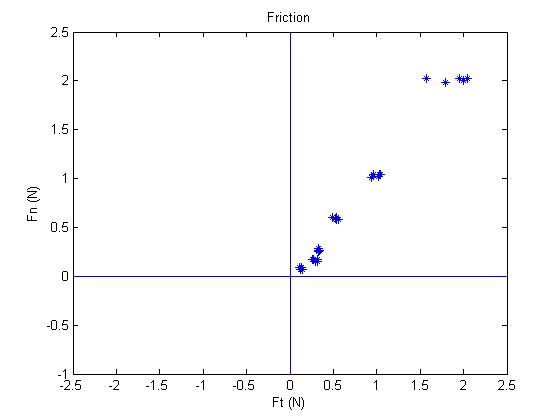new web: http://bdml.stanford.edu/pmwiki
TWiki > Rise Web>ClimbingRobot > RobotSimulation > ContactModeling > AdhesionModels>PulleyStageTests (13 Jul 2006, DanielSantos? )
Rise Web>ClimbingRobot > RobotSimulation > ContactModeling > AdhesionModels>PulleyStageTests (13 Jul 2006, DanielSantos? )
Pulley Stage Tests
Preliminary tests of flat and spherical urethane pads using weights and pulleys. -- SalomonTrujillo - 05 Dec 2005- Circuit for IR emitter detector to sense the onset of sliding motion IREmitter-DetectorPair.doc
08 Dec 2005
Sal and Dan began testing 1st adhesive pad - 90A(?) circular pad of urethane glued to hard urethane backing, diameter ~?? Ran the following procedure:- Pre-load with given weight
- Wait ~2min
- Remove Pre-load
- Wait given "relax" time
- Pull-off and record max force
| Tria l # | Pre-Load | Relax Time |
| 1 | 100 grams | 0 min |
| 2 | 10 grams | 0 min |
| 3 | 10 grams | 0 min |
| 4 | 10 grams | 0 min |
| 5 | 10 grams | 1 min |
| 6 | 10 grams | 1 min |
| 7 | 10 grams | 1 min |
10 Jan 2006 - Maximum Adhesion under Negative Normal Impulse given Positive Normal Pre-Load
Sample - Urethane Patch of ~1.2" diameter glued to hard urethane backingSubstrate - Clean acrylic plate
Sampling Rate - 1000 Hertz
Experimental Procedure:
- Clean sample using damp cloth (wipe off any dirt/lint)
- Allow sample to air dry approximately 30 to 60 seconds
- Place sample on substrate and apply pre-load for approximately 1 minute
- Begin recording data from 6-dof force plate
- Remove pre-load and quickly apply large negative normal impulse
- After "break-away" stop recording
- Data-1-10-06.jpg:

11 Jan 2006 - Maximum Adhesion under Negative Normal Impulse given Postive Normal Pre-Load and Side-Load
Sample - Urethane Patch of ~1.2" diameter glued to hard urethane backingSubstrate - Clean acrylic plate
Sampling Rate - 1000 Hertz
Experimental Procedure:
- Clean sample using damp cloth (wipe off any dirt/lint)
- Allow sample to air dry approximately 30 to 60 seconds
- Place sample on substrate and apply normal pre-load and side-load for approximately 1 minute
- Begin recording data from 6-dof force plate
- Remove normal pre-load but keep side-load, and quickly apply large negative normal impulse
- After "break-away" stop recording
- Note: At 200g Side-Load, sample slipped before Negative Normal Impulse could be applied
- Data-1-11-06.jpg:

12 Jan 2006 - Coulomb Friction with No Pre-Loads
Sample - Urethane Patch of ~1.2" diameter glued to hard urethane backingSubstrate - Clean acrylic plate
Sampling Rate - 1000 Hertz
Experimental Procedure:
- Clean sample using damp cloth (wipe off any dirt/lint)
- Allow sample to air dry approximately 30 to 60 seconds
- Place sample on substrate and apply normal load
- Begin recording data from 6-dof force plate
- Increase side-load until sample begins to slip
- Stop recording data
- Data-1-12-06.jpg:

Ideas, requests, problems regarding TWiki? Send feedback